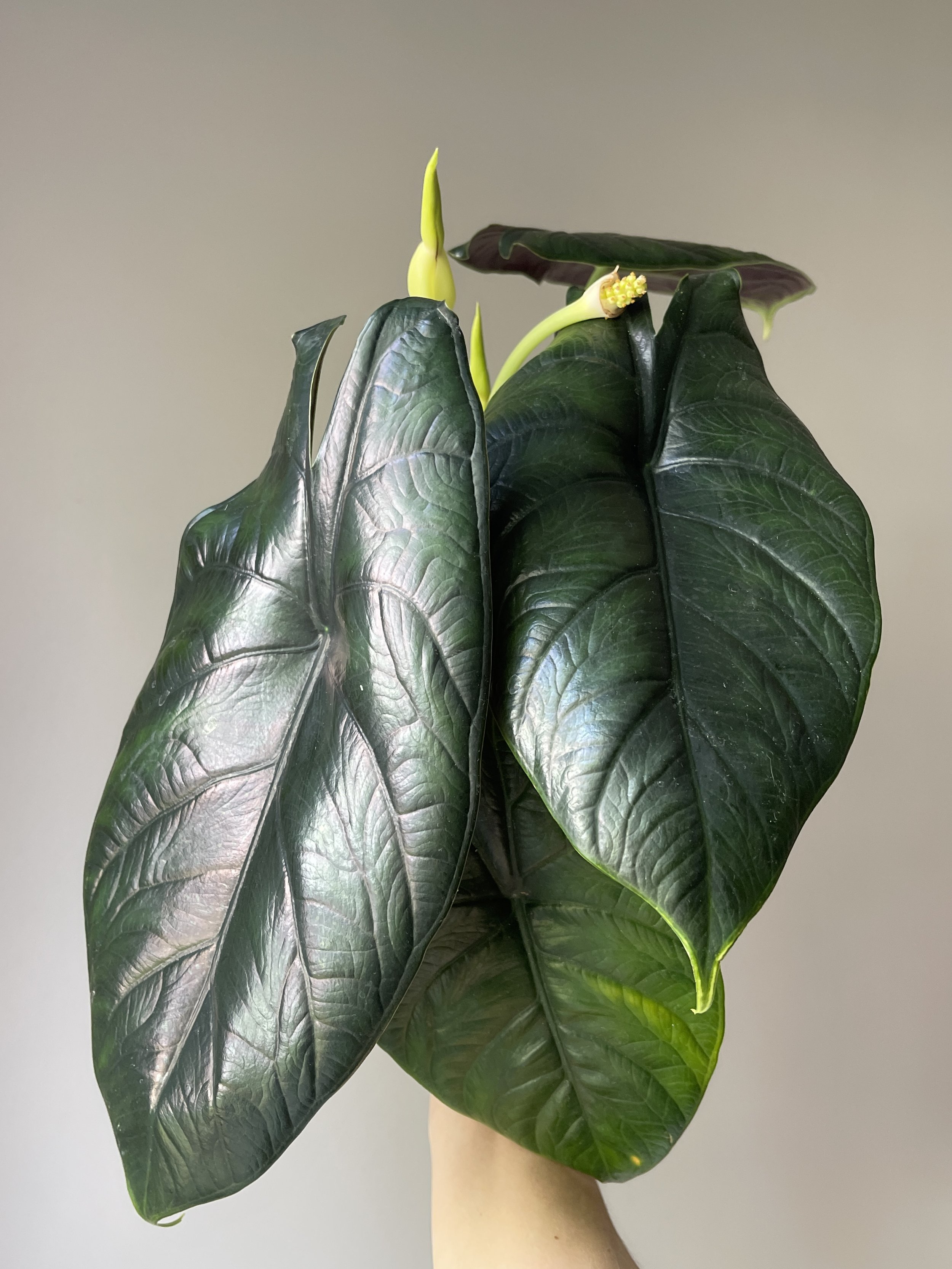ALOCASIA ‘GREEN UNICORN’
Alocasia azlanii x Alocasia baginda ‘Dragon Scale’
PARENTAGE: Alocasia azlanii x Alocasia baginda ‘Dragon Scale’ (pollen)
HYBRIDIZER: Lindsay Sisti (@alltheplantbabies) - 2021/2022
Pollination took place on July 29, 2021 and the first berry was harvested December 23, 2021 (all berries ripened by January 7, 2022). First propagation was done by corms that were harvested June 1, 2022, which came into maturity September 22, 2022. The hybrid cultivar was patented under PP35554
VARIEGATION: N/A
DESCRIPTION:
Light yellow green leaves, glabrous and glossy, characterized by dark red interveinal areas, light yellow green primary and secondary veins (with slight dark red tinge on the latter). Veinlets are grenish white and margins are light yellow green. Petioles are flexible, semi-erect and overly arching towards the lamina. 17.5 to 19.7 cm in length, 1.4 cm base diameter, narrowing to 0.5 cm at the insertion point into the leaf. Primary lobes are approximately 3.8 cm long and 1.6 cm wide at the base. Yellow sheath - 6.4 cm long and 1 cm wide.
INFLORESCENCE:
Peduncle is strong yellow green fading to a pale yellow green at the base of the spadix. 8 cm long and 6 mm in diameter, widening to 8 mm at the base of the spadix. The spathe is hooded, bract, with a subtending spadix. Its shape is rotund above female zone, and elliptical surrounding female zone with an aristate apex and a truncate base. Margins are tinted purplish red above the female zone, 5.4 cm above female zone and 2.3 cm surrounding female zone. 3.2 cm in width above female zone and tapering towards the apex, 2.0 cm in diameter surrounding female zone. Spadix is 6.0 cm long, narrowly pointed. Pale green and lanceolate appendix (~3.5 cm long and 0.5 mm wide), white cylindrical male zone, 1.5 cm long and 6 mm wide.Greenish yellow, conical female zone, 1 cm long and 5-8 mm wide.
COMPARISON WITH PARENTAL VARIETIES
Alocasia ‘Green Unicorn’ differs from the female parent species Alocasia azlanii in that Alocasia ‘Green Unicorn’ leaves are iridescent and dark greyish green on the adaxial surface and dark red on the abaxial surface, whereas the female parent has leaves that are dark coppery purplish green on the adaxial surface and pale green on the abaxial surface. Additionally, Alocasia ‘Green Unicorn’ has secondary veins that are moderate yellow green on the adaxial surface, whereas the female parent has distinct secondary veins that are maroon on the adaxial surface. Furthermore, Alocasia ‘Green Unicorn’ has leaf veins that are impressed on the adaxial surface with a bullate surface between the veins, whereas the female parent has leaf veins that protrude on both the adaxial and abaxial surfaces.
The Alocasia azlanii specimen that served as ovule parent of Alocasia ‘Green Unicorn’
The Alocasia baginda ‘Dragon Scale’ specimen that served as ovule parent of Alocasia ‘Green Unicorn’
Alocasia ‘Green Unicorn’ differs from the male parent Alocasia baginda ‘Dragon Scale’ in that Alocasia ‘Green Unicorn’ has glabrous and shiny leaves that are dark greyish green on the adaxial surface and a slightly bullate surface between the veins, whereas the male parent has matte leaves that are dark green and bullae that are pale grey on the adaxial surface. Additionally, Alocasia ‘Green Unicorn’ has leaves that are dark red on the abaxial surface with a light yellow green primary vein, whereas the male parent has leaves that are pale green on the abaxial surface with a deep red coloration on the distal portion of the primary vein as well a deep red coloration on the secondary and marginal veins. Furthermore, ‘Green Unicorn’ has a slightly more compact growth habit and smaller leaf size compared to the male parent. Finally, ‘Green Unicorn’ has more flexible and thinner glabrous leaves, whereas the male parent has thicker and stiffer coriaceous leaves.
Lindsay was graceful enough to share the journey of her hybrid, from pollination to berry ripening, from seed planting to maturity, and finally to propagation via terminal bulbils (corms).


















